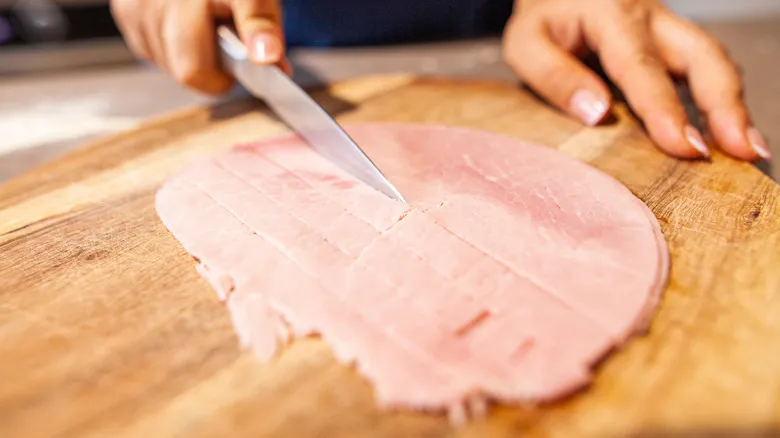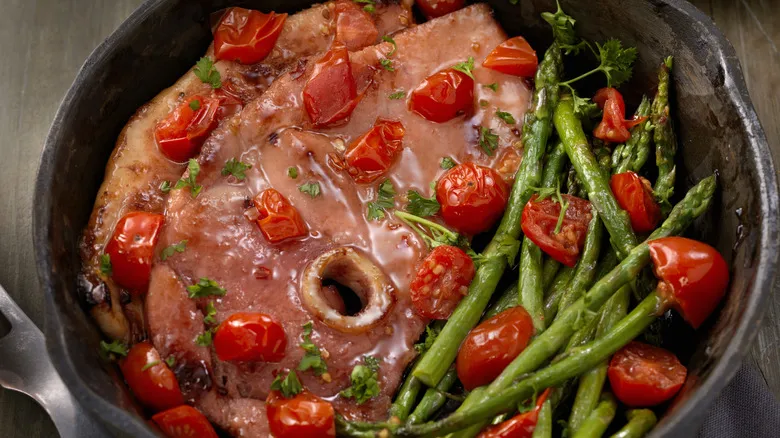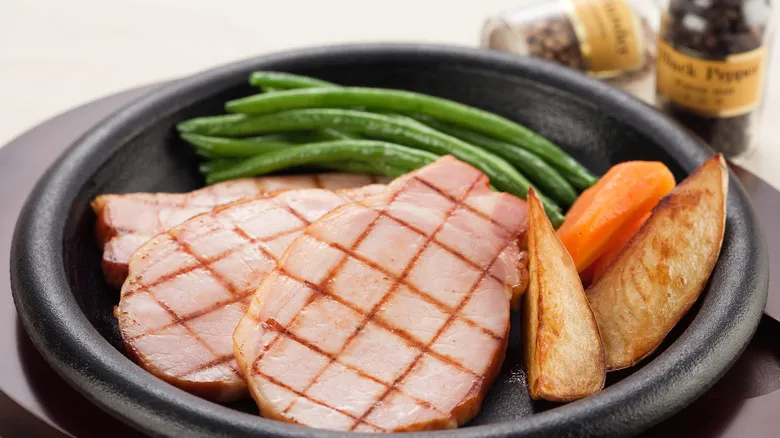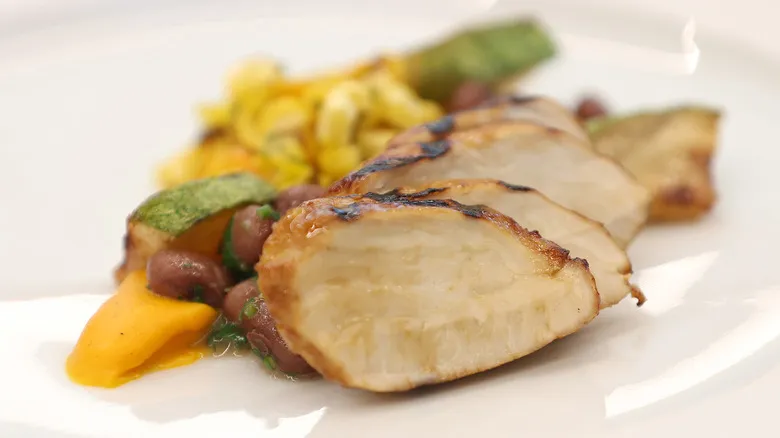Ham steaks are versatile cuts of pork

Ham steak refers to various cured cuts that are prepared in a similar way. Typically, this cut is a type of city ham, which means it is wet-brined and smoked before being sold. This variety is fully cooked, giving it a quality akin to other popular deli meats. However, there are also raw ham steak options available, so it's important to check the label before buying.
The cut is commonly sold either bone-in or with a hole, as it is taken from the leg or shank. It is sliced into a large, thick cross-section, ranging from ½ inch to 2 inches in thickness, and usually weighs around 2 pounds. This steak-like quality distinguishes it from other hams — its substantial nature makes it suitable for a complete dinner without being overpowering in flavor.
Moreover, ham steaks are a type of center cut, characterized by a smooth texture and a vibrant reddish color typical of this kind of pork. With a leaner composition, they contain only a few slivers of fat and no marbling. Their meatier quality means there’s no concern about excessive fat melting during cooking — the meat beautifully caramelizes under high heat. Not too chewy or greasy, it’s a well-balanced type of cured pork that pairs well with simple sides like potatoes, asparagus, or a fresh salad.
They can be prepared with different methods

Pan-searing is the most straightforward method for cooking ham steak. Just like with other steaks, heat a skillet with some oil. You might want to season it with spices such as cayenne, garlic powder, and dried herbs. For an extra touch of caramelization, sprinkle a bit of brown sugar at the end to form a tasty crust. Keep in mind to use salt sparingly, as the cut is already brined, and be careful not to overcook the meat.
If you prefer a smoky flavor, grilling is another excellent option for ham steaks. Preheat the grill to medium heat, then place the oiled pork steak on the grates. Ensure the ham steak is cooked through—about five minutes per side or until it reaches an internal temperature of 140 degrees Fahrenheit is ideal. Instead of spices, consider using a glaze to enhance the flavor. You could try a grilled version of the classic honey mustard glaze, opt for orange marmalade for a fruity twist, or incorporate some bourbon-infused brown sugar to complement the pork.
Lastly, another method to prepare ham steak is in the oven. If you’re looking for a seared, crispy texture, broiling is a fantastic option. Place the ham steak in a pan with a glaze and broil it on moderate heat for just a few minutes. Alternatively, for a more gentle, slow-cooked approach, simply bake the meat in the oven for about half an hour.
Ham steaks trace back over a century

Ham has a long history, dating back centuries — the Chinese are believed to have cured the first hams as early as 4900 B.C. Over time, this method of preparation made its way to Rome, where it became a staple in various European cuisines. Christopher Columbus introduced pork to North America during his initial voyages, and through the Columbian Exchange, the practice of curing pork flourished among both New World settlers and Native American communities. Consequently, diverse ham production techniques emerged globally.
The ham steak style originated with the advent of wet brining, closely associated with English hams from Wiltshire. This technique is thought to have developed in the 1840s, involving the immersion of large leg hams in a saline solution, resulting in a meatier and milder cured product. While the exact origins remain unclear, it is likely that the ham steak cut gained popularity shortly thereafter.
In the United States, ham steaks gained significant popularity during the 1950s, a period marked by the rise of processed foods. Often served alongside sides like potatoes and peas, they provided quick and easy meals that could be prepared straight from the refrigerator. In fact, ham steaks became linked to their own nostalgic memorabilia, sometimes packaged in unique tins. While they may not be as eccentric as other foods from the 1950s, ham steaks certainly warrant a closer look.
Recommended

Rice Wine Vs Rice Vinegar: Are They The Same?

The Science Behind What Makes Instant Noodles Instant

How To Identify Lab-Grown Chicken When It Finally Hits Grocery Store Shelves

Should You Store Bananas In The Fridge Or At Room Temperature?
Next up

